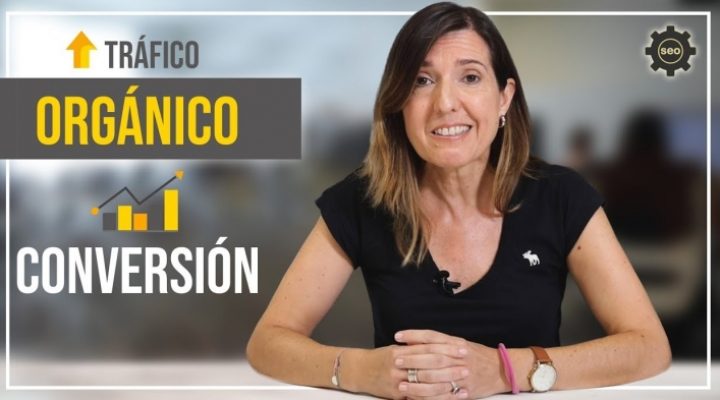If you've gotten to this article, it is because you are looking for to know what is search intent, and why it is so important for SEO. So let's explain it carefully, because it's going to be a point differential between achieving a good ranking in Google.
What is search intent in SEO?
When we talk about search intent, we refer to those results Google is displaying for a keyword in particular.
That is to say: If we search for “duck”, the results that Google is going to return will be pages or videos of recipes:
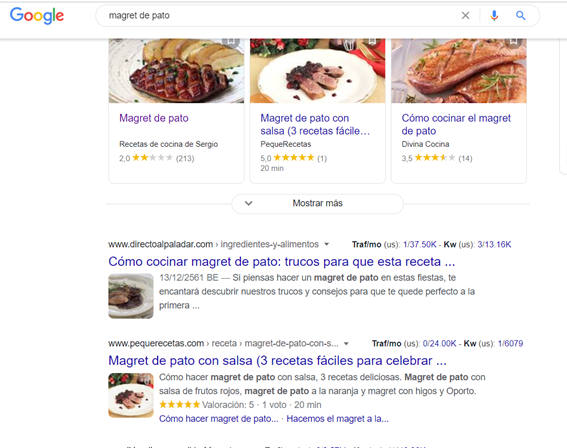
In contrast, only that you add the keyword “buy” or “price,” in front of this, the search intent has already completely changed, and instead of step results information or recipes, we are going to show results transactional:
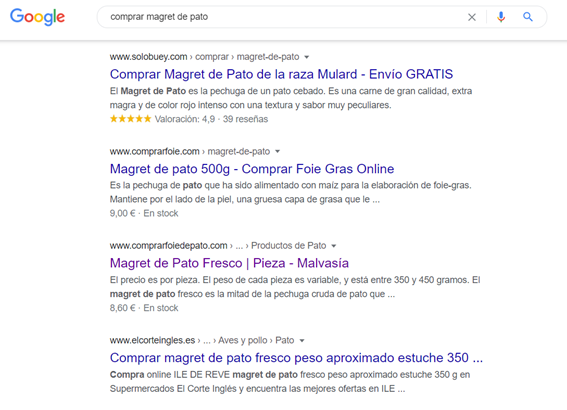
Here the importance of search intent in the organic ranking in Google. Whether you decide to bet on one keyword or another, going to behave that offer different content to the user.
Why is it important to verify the intent of a keyword?
First, we want to emphasize that it is not something “optional” that can be done or not. If you want your results to the position of the organic form in the top positions of the SERPs of Google, check the search intent of a keyword IS A MUST.
And it is that this point becomes as important, for if us as a user search for “cow” in Google, we hope to obtain a series of results in particular, right?
In this case, we would like to see a listing of pages that provide information about the cow (which is a cow, features, what it eats,...).
But you will agree with us that if we add the word “buy” in front, as the search intent as user changes completely: because you are not interested in knowing about the life and passions of the cows, but what you want is to buy beef.
Ok, made this introduction from the perspective of the user, let us now from the point of view of us as webmasters or owners of a web page.
Let's say we have a website where we sell duck meat, and we want to make a landing for each product: What keyword you believe that there will be more optimized for a user to find our duck breast:
- Duck breast
- Buy or Price of the duck breast
Obviously the second keyword (with both variants separately “buy” and “price”), will guide the user toward a more transactional than the first search.
Made this brief introduction, now we are ready to get to know the different intentions of search there, and in the following section, we will explain finally how to detect the search intent of a keyword in the SERPs of Google.
Types of intentions to search in SEO
So, after this introduction, let's see the different intentions or types of searches that exist.
Keywords transactional

As we can see in the picture, when we seek to “Price Foie gras”, Google returns only results-oriented transaction, that is, results that are in general stores and sell products.
This is one of the most characteristic features of the intentions of search transactional: The web results that are listed have products for sale.
Keywords informational
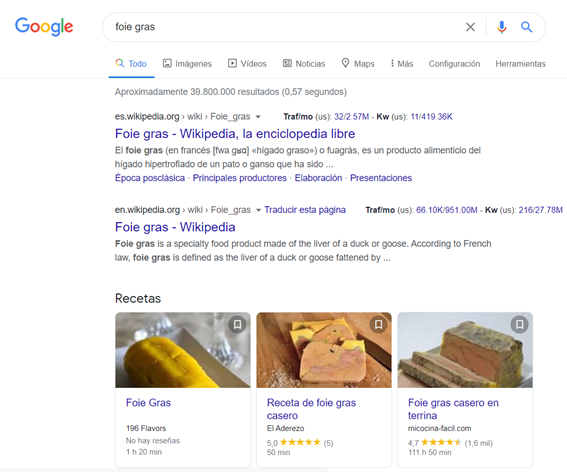
On the other hand, we see exactly that the contrary happens when we do a search informational or informative in Google, as it is the example of the previous image for the keyword of “foie gras”.
As we can see, first we get the KING OF the CONTENT and INFORMATION literacy: Wikipedia. Followed by, how not, from cooking recipes to make foie gras.
It is important to understand what content is showing up Google for a keyword in particular, for us to be able to create a type of content or another.
Keywords navigational
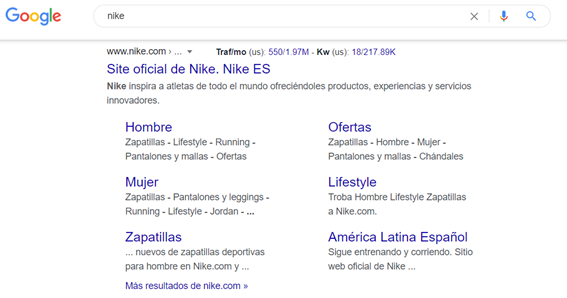
This is perhaps the search intent more easy to identify, since it corresponds simply to the keyword brand or company, we are looking for.
An example of this, is the one shown in the image above. “Nike” is the name of a brand, and therefore, the results that we're going to get is going to correspond to the web page of the same, social networks, etc ..
Keywords generic
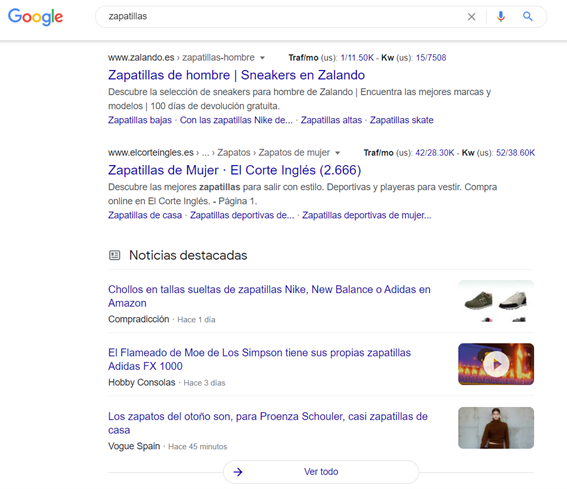
Finally, we have another type of keyword that there are many ways of calling them, so we have chosen to name them “keywords generic”, because they can give rise to different types of searches different between them.
As we can see in the picture above, for the keyword “shoes”, we have the intentions to search spread between the results of transaction (in which we are going to find goods), and results of informational news (see the section “featured News”).
How to check the search intent
As we have been seeing, the search intent in seo, is one of the most important factors in the organic ranking of Google. That's why, we will be of vital importance to identify when a keyword or not an intention of specific search.
So, what is the procedure to verify the intent of a keyword?
1. Make the Google search: The first step, and perhaps the most important, is to do a Google search for the keyword that you want to work, and observe the results that Google returns. IMPORTANT: To verify the intentionality, we must ALWAYS look at the results purely SEO. Thus, the results of payment (ads and shopping), or case. And with only observing the results that Google offers us, because we can get an idea of what intentionality is rewarding for positioning (specifically, what we find with the types of metatags: Prices, buy...).

2. Check the contents: In the second place, and not least important, we will need to enter in the 3 / 4 first results, and verify the type of content with which they are positioning these pages. We will be of vital importance to us and then, to get an idea of what type of sections, we'll include it in our landing, and what type of content you are going to have the same. What the first results are positioning products? For sure we'll need products to be able to compete for this keyword.
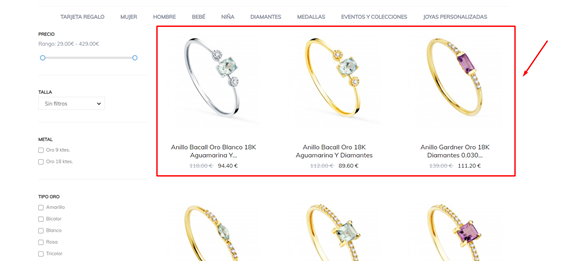
3. Create our landing: Finally, once you have collected all this information, we can only create the content that we will incorporate in our landing.
Important aspects of intentionality
As we already saw in the tutorial how to do a keyword researchwhen we need to create a landing on our website, we're going to need mandatory to include keywords or keywords to position organically in Google.
But let's eye, that not all of the keywords that we find are valid!
When looking for suggestions for keywords using the planner Google keyword, we get many different results which, apparently, are related to each other. But... What you really are?
Let's look at what happens if we search for “that is the vermouth” in the keyword planner of Google:
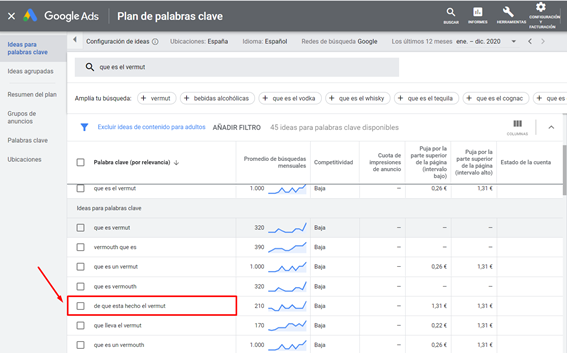
First, it offers us a thousand and one combinations of this keyword, but look at that we have pointed out “that is made of vermouth”.
Intuition tells us that, if we're going to talk about “what is vermouth” in a blog article, we will be able to include a section perfectly in the to explain what it's made of the same. But put into practice what we have been talking about intentions of searches seo:
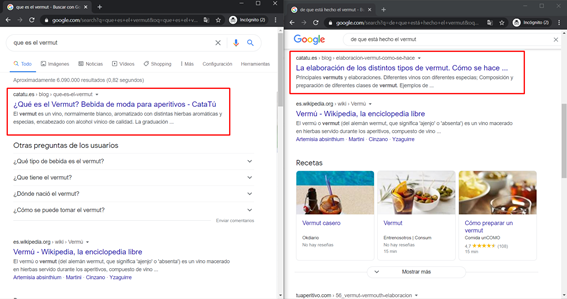
Look at the first results displayed by Google. Is the web itself, but it is positioning itself with two blog articles different between them.
That is the magic of SEO, it doesn't matter if something seems or not very obvious, what matters in the end is what Google is showing (because, obviously, it is understood that the user wants to see).
Here we are taking out a last tip for when we are doing keyword research, and we doubt if we can combine two keywords in the same article, or a better break them up into posts for different needs:
- Open 2 tabs incognito in Google.
- Do two separate searches.
- Check the following:
- What Google shows the same websites?
- What are the websites that displays Google are positioning themselves for the same url?
- What type of websites they are positioning?
To all this, we should add an extra point that you're going to save a lot of headaches:
When ye may prove an intention to search, try to take as reference websites which are not very known such as Amazon, Rastreator, Archery, etc
The main reason is because these sites have so MUCH AUTHORITY, that already positioned for everything. And if we want to compete with a web of 0, take it as a reference to these giants were not going to help us to gather ideas.

